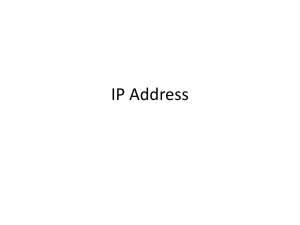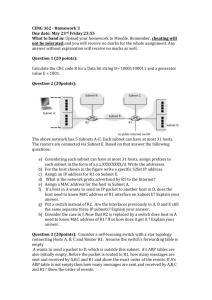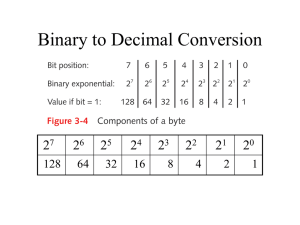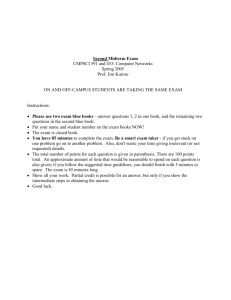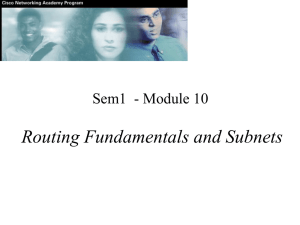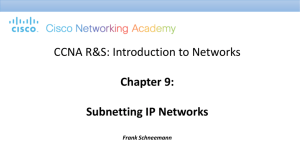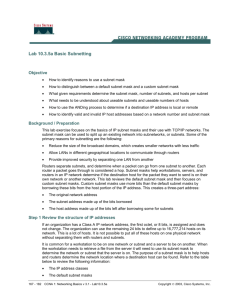1 Subnetting Subnetting is used to subdivide a single class of
advertisement
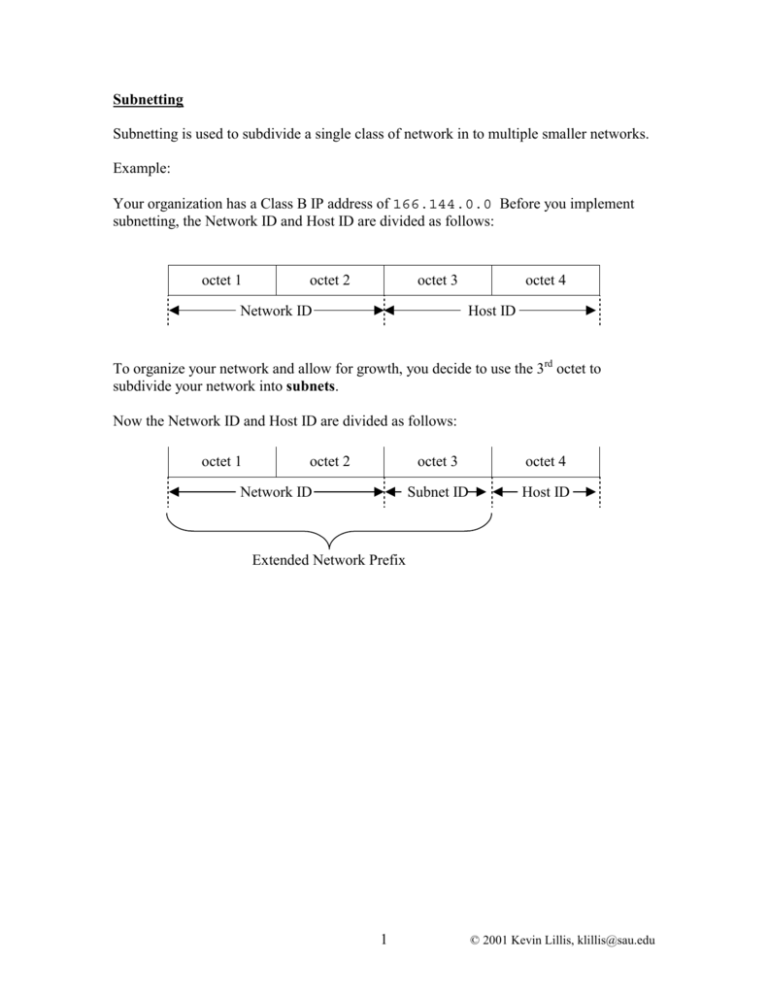
Subnetting Subnetting is used to subdivide a single class of network in to multiple smaller networks. Example: Your organization has a Class B IP address of 166.144.0.0 Before you implement subnetting, the Network ID and Host ID are divided as follows: octet 1 octet 2 octet 3 Network ID octet 4 Host ID To organize your network and allow for growth, you decide to use the 3rd octet to subdivide your network into subnets. Now the Network ID and Host ID are divided as follows: octet 1 octet 2 Network ID octet 3 octet 4 Subnet ID Host ID Extended Network Prefix 1 © 2001 Kevin Lillis, klillis@sau.edu Subnet Mask In order to distinguish between the extended network prefix and the Host ID you use a subnet mask. A subnet mask fills each bit of the extended network prefix with a 1 and each bit of the Host ID with a 0. In the above example the network mask would be: 11111111 11111111 11111111 00000000 Which in dotted decimal notation is: 255.255.255.0 A router combines the destination IP address with the subnet mask, using a logical AND operation, to determine the network address. Continuing with the same example, a destination address of 166.144.56.9 is combined with the subnet mask of 255.255.255.0 as follows: AND 10100110 10010000 00111000 00001001 11111111 11111111 11111111 00000000 10100110 10010000 00111000 00000000 (166.144.56.9) (255.255.255.0) (166.144.56.0) After combining the destination address with the subnet mask, the result is the extended network prefix. In effect, the host potion of the address has been stripped off. Default Subnet Masks There is a default subnet mask for each of the three Classes of IP address: Class A: 255.0.0.0 Class B: 255.255.0.0 Class C: 255.255.255.0 2 © 2001 Kevin Lillis, klillis@sau.edu Another Example Your company has a Class C network of 201.222.10.0 and you want to use subnetting. You cannot simply use the next available octet following the Network ID as in the previous example. If you did, there would be no portion of the IP address left for the Host ID. Therefore, you need to use one portion of the last octet as the Subnet ID and another portion of the last octet as the Host ID. To do this you must follow these general steps: Step 1 – Step 2 – Step 3 – Step 4 – Step 5 – Step 6 – Step 7 – Determine the number of subnets required by your installation Determine the number of bits, n, needed for the Subnet ID field Determine the number of bits, m, needed for the Host ID field Determine the subnet mask for your network Determine the total number of subnets available Determine the maximum number of hosts per subnet For each subnet determine: a) The network address b) The range of host addresses c) The broadcast address Step 1 – Determine the number of subnets required by your installation This will depend on your current installation and is used as the starting point for this discussion. In this example we will assume that we require 17 subnets. 3 © 2001 Kevin Lillis, klillis@sau.edu Step 2 – Determine the number of bits, n, needed for the Subnet ID field This can be done in two ways. The first way is intuitive and involves simply looking at the decimal values of various binary numbers and deciding the minimum number of bits required to represent the number of subnets. The second way is more analytic. The number of bits required is defined by the following equation: number of subnets = 2n – 2 Once you know the number of subnets required, you can solve the equation for n to determine the number of bits to use for your Subnet ID. In this example the number of subnets needed is 17. Therefore, 17 = 2n – 2 Solving for n 17 = 2 n − 2 17 + 2 = 2 n 19 = 2 n ln(19) = ln(2 n ) ln(19) = n ln(2) ln(19) =n ln(2) n ≈ 4.2 Since it makes no sense to talk about 4.2 bits, we will say that the number of bits required to represent our 17 subnets is 5. Step 3 – Determine the number of bits, m, needed for the Host ID field This is defined as m = 32 – number of bits in the Network Address – n In this example we have a Class C address which uses the first three octets (24 bits) for the Network ID. In the previous step we determined that n = 5. So m = 32 – 24 – 5 m=3 4 © 2001 Kevin Lillis, klillis@sau.edu Step 4 – Determine the subnet mask for your network. As stated above, a subnet mask fills each bit of the extended network prefix with a 1 and each bit of the Host ID with a 0. So first the extended network prefix needs to be identified. One way to do this is to write the network IP address in its binary form and draw a vertical line just to the right of the Network ID field. Network IP network address = 201.222.10.0 in binary this is 11001001 11011110 00001010 00000000 Next, count n bits from the vertical line and draw a second vertical line. 11001001 11011110 00001010 00000000 These two vertical lines divide the 32 bit IP address into three sections, corresponding to the Network ID, Subnet ID, and Host ID fields respectively. The extended network prefix consists of the Network ID and Subnet ID fields. Filling each bit in these fields with a 1 and filling the bits of the Host ID field with 0 will give us the network mask. 11111111 11111111 11111111 11111000 In dotted decimal notation this is subnet mask = 255.255.255.248 Step 5 – Determine the total number of subnets available This can be determined by number of subnets = 2n – 2 where n = the number of bits used for the Subnet ID field. in this example n = 5, so number of subnets = 25 – 2 = 30 5 © 2001 Kevin Lillis, klillis@sau.edu Step 6 – Determine the maximum number of hosts per subnet This is defined as number of hosts per subnet = 2m – 2 where m = the number of bits used in the Host ID field In this example m = 3, so number of hosts per subnet = 23 – 2 = 8 – 2 = 6 Step 7 – For each subnet determine: a) The network address b) The range of host addresses c) The broadcast address In this example there are 30 possible subnets. We will consider only one. a) Determine the network address We will select the first subnet, which is 11001001 11011110 00001010 00001000 In dotted decimal notation this is 201.222.10.8 b) Determine the range of the host addresses In any IP address, the Host ID field can contain any combination of 1s and 0s, except the combination of all 1s and the combination of all 0s. Therefore the first host address is 11001001 11011110 00001010 00001001 In dotted decimal notation this is 201.222.10.9 6 © 2001 Kevin Lillis, klillis@sau.edu The last host address would likewise be 11001001 11011110 00001010 00001110 In dotted decimal notation this is 201.222.10.14 So the range if host addresses is 201.222.10.9 to 201.222.10.14 c) Determine the broadcast address In broadcast address for an IP network simply fills the Host ID field with all 1s. So the broadcast address would be 11001001 11011110 00001010 00001111 In dotted decimal notation this would be 201.222.10.15 7 © 2001 Kevin Lillis, klillis@sau.edu

